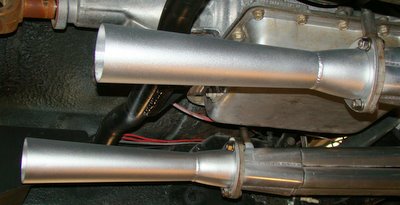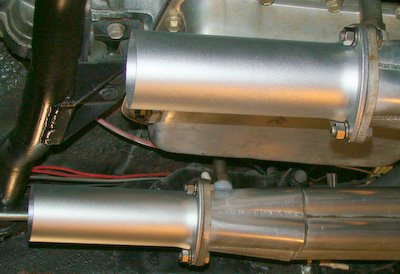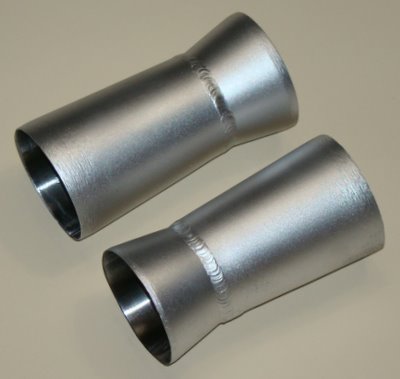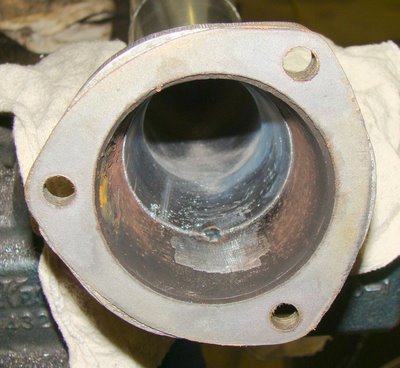| | | | | Improving performance using "Venturi" Collector Extensions/Exhaust System Inserts
Using My Old Dodge at the top of this page, we conducted a series of tests at a local drag strip over a two day weekend comparing "normal" (straight) collector extensions and "venturi" (shaped) collector extensions. The performance gained by switching to the "venturi" collector extensions was quite impressive.
Besides the gains documented below, on Sunday - with the "venturi" collector extensions now being used - at the starting line the Dodge lifted its left front tire off the track as much as 1" on 3 different runs! The third run was announced over the track's public address system and we verified this by talking to the track announcer the following week. In that conversation we learned he had actually seen the car lift the tire off the track on two previous runs but he said that he couldn't believe that had happened because he felt that the car was too heavy and too slow to have done this. When the car did it the third time he realized it was no longer a "fluke" occurrence and then announced what he had just seen the car do! (Not a bad gain for a "bolt-on" header design change!)
Below is a chart detailing all of the runs at the drag strip. Following the chart is considerable discussion as to what took place and the performance benefits one might obtain - at the track (drag strip, circle track, etc.) AS WELL AS on the street by using "venturi" collector extensions and exhaust system inserts.
| "Straight" vs. "Venturi" Collector Extension Test | | Day | Run
# | Time
of
run | Elapsed
Time(Secs) | Miles
per
Hour | 60'
Times
(secs) | Peak
Acceleration
Rates (Gs) | Notes | | Sat | 1 | 10:53 | 14.130 | 94.64 | 1.975 | 1.06 | Straight Collector Extensions - Fuel Map 1 | | Sat | 2 | 11:54 | 14.240 | 93.65 | 1.956 | 1.09 | Straight Collector Extensions - Fuel Map 1 | | Sat | 3 | 13:22 | 14.009 | 95.15 | 1.927 | 1.11 | Straight Collector Extensions - Fuel Map 1 | | Sat | 4 | 14:07 | 14.083 | 93.64 | 1.911 | 1.06 | Straight Collector Extensions - Fuel Map 1 | | Sat | 5 | 14:31 | 13.941 | 95.23 | 1.920 | 1.22 | Straight Collector Extensions - Fuel Map 2, Hit Rev Limiter | | Sat | 6 | 14:52 | 13.988 | 94.46 | 1.906 | 1.09 | Straight Collector Extensions - Fuel Map 2 | | Sat | 7 | 15:19 | 14.046 | 94.61 | 1.938 | 1.05 | Straight Collector Extensions - Fuel Map 2 | | Sat | 8 | 16:08 | 13.988 | 94.16 | 1.891 | 1.03 | Straight Collector Extensions - Fuel Map 2 | | Sat | 9 | 16:32 | 14.012 | 94.34 | 1.921 | 1.09 | Straight Collector Extensions - Fuel Map 2 | | Sat | 10 | 17:12 | 14.002 | 95.19 | 1.910 | 1.14 | Straight Collector Extensions - Fuel Map 2 | | Day's Averages | 14.044 | 94.51 | 1.926 | 1.103 | | | Sun | 1 | 9:09 | 13.683 | 96.51 | 1.859 | 1.18 | Venturi Collector Extensions - Fuel Map 2 | | Sun | 2 | 9:21 | 13.905 | 95.31 | 1.888 | 1.12 | Venturi Collector Extensions - Fuel Map 2 | | Sun | 3 | 9:43 | 13.871 | 95.52 | 1.880 | 1.33 | Venturi Collector Extensions - Fuel Map 2 | | Sun | 4 | 10:16 | 13.717 | 96.18 | 1.852 | 1.26 | Venturi Collector Extensions - Fuel Map 3, Hit Rev Limiter | | Sun | 5 | 11:12 | 13.842 | 95.46 | 1.883 | 1.04 | Venturi Collector Extensions - Fuel Map 3
Broad Range, - .98, .97, .89, 1.04 Gs. | | Sun | 6 | 11:25 | 13.820 | 95.30 | 1.869 | 1.41 | Venturi Collector Extensions - Fuel Map 3 | | Sun | 7 | 12:16 | 13.915 | 95.29 | 1.924 | 1.17 | Venturi Collector Extensions - Fuel Map 3, Hit Rev Limiter
Broad Range - 1.01, 1.02, 1.02. .91, 1.15, 1.17 Gs | | Day's Averages | 13.822 | 95.65 | 1.879 | 1.216 | Removing runs #5 and #7, the Peak Acceleration Rates
of the 5 remaining runs averages 1.26 Gs! | | Average GAINS | .222 | 1.14 | 0.047 | 0.157 | Sunday's #5 & #7 runs NOT included in Average Peak GAINS. | | | Green cells indicated best numbers of that day. |
GAINS Discussion: Looking at the numbers and considering the weight of the "test" car (3830# w/driver at this time), the gains in ET and MPH represent a 15-20 Horsepower increase. The gains in 60' times and Peak Acceleration Rates indicate a BROAD RPM power increase (increased bottom and mid-range power) which is often VERY HARD to accomplish and also establishes the design concept as a VERY Street oriented performance modification as well. See Comments below.
Test Methodology: Peak Acceleration Rate numbers were obtained using a Tesla Electronics EGS [recording] Tach with added accelerometer module. Acceleration measurements were recorded/logged at .1 second intervals. Peak acceleration numbers are easily recognized because they are so much larger than earlier/later measurements. All other numbers came from Brainerd International Raceway time slips.
Unusual results in Sunday's Runs #5 and #7: These two runs were noticeably different in that the peak acceleration rate numbers were not as high as recorded on other runs BUT were actually maintained over a time period. Run #5 had four measurements (representing at least a .3 second overall duration) that averaged .970 Gs. Run #7 had six measurements (representing at least a .5 second overall duration) that averaged 1.046 Gs.
Extension Descriptions (diameters would be different for other engine combinations): The STRAIGHT EXTENSION had a 3" OD Inlet (ID matched Collector Outlet ID) and was 8" long; The VENTURI EXTENSION inlet matched the Straight Extension inlet but tapered down over a 3" length to 2" OD (1 7/8" ID) and then tapered up much more gradually to 3" OD over a 12" length. The length of the Venturi Extension was 15" long. Both extensions had "blued" areas from exhaust heat - and thus could be shortened to the far end of the "blued" areas to further improve performance. (Straight Extension could be shortened 2", Venturi Extension could be shortened 4".)
Weather: Since this "test" was run over a two day period, any change in the weather would obviously affect the results of the test. Fortunately, the weather did NOT change much from one day to the next. Effective altitude at the drag strip was about 2000' at the start of each day but increased to about 4000' by 11:00 both days so weather changes can be essentially eliminated as having affected the test results.
Comments: The engine - a small block Chev RamJet 350 Crate Engine - is a retuned 350" port injected, computer controlled engine with a rev limiter that prevented the engine from exceeding 5500 rpm. 1-2 shifts are made automatically by the transmission (a 700R4), 2-3 shifts are made manually. The 5500 rpm rev limit was "hit" on Saturday's #4 2-3 shift and Sunday's #4 and #7 2-3 shifts. Obviously the ET/MPH numbers on those runs were worse than they could have been but the 60' times and the Peak Acceleration Rate numbers would not be affected. NO burnouts made prior to runs! Converter stall rpm at launch only about 1900-2000 rpm. TRUE Equal Length Header Design (NO measureable error in tube lengths). Header dimensions are 1 5/8" OD x 38" long with hand-built Custom Collectors and our Cross-+-Entry tube shaping. After seeing how well the "venturi" collector extensions worked at the drag strip, a few days later SMALLER 2 3/8" OD x 1 3/4" ID x 2 3/8" OD versions ("venturi" inserts) were made and then inserted and tack-welded INSIDE the car's 2 1/2" exhaust system to further improve street/part throttle performance!
If you want to know more about the test car, look at the My Old Dodge page.
A little history.
While this discussion may be new to many of you who will read it, nothing here is actually new because we've been testing with various bolt-on collector extensions - lengths, diameters, and shapes - since the mid-to-late 1960s (look at the Cheap Performance Gains page for additional discussion). Also - through our Header Design Advice Service we have continually encouraged others to also experiment with collector extensions (and exhaust system inserts) for about 35 years now!
What IS different here is that we have thoroughly documented a specific instance of using a specific type of collector extension so that others might see the advantages of incorporating the same type of change in their own particular headers and/or exhaust systems.
Design theory.
When the exhaust gases go through the "venturi" extension, initially they are compressed to a degree as well as speeded up considerably as they travel down the shorter inlet cone and approach the narrow "venturi". When they leave the "venturi" area the considerably faster exhaust gases start to expand but, by using a much longer outlet cone, they expand in very controlled manner (minimal turbulence created during the expansion process) - in a much more flow efficient manner.
The much higher gas velocity created inside of the "venturi" extension COMBINED with the improved flow efficiency of the much longer outlet cone (so no restriction actually takes place - assuming the small diameter is selected properly) - improves the overall scavenging characteristics of the header - which not only translates to improved performance but, even better, does so over a broad rpm range!
(It should also be pointed out that these cones are very carefully positioned in an alignment fixture to absolutely minimize any sharp edges being in the exhaust stream. Then, after the welding of the junction is completed, the junction is internally polished to not only eliminate any sharp edges that, somehow, might still be there but to also add a slight internal radius as well.)
"Corking" the motor?
While the reduction of the collector diameter from 3" to 2" might appear quite restrictive, the results at the drag strip does NOT back up that opinion as BOTH the MPHs and Elapsed Times were measurably improved over a much larger diameter.
Also prior to this particular series of tests, two other header design "size" situations had come about: (1) Previously we had spent an entire day at the drag strip experimenting with collector extension diameters - 2 1/2", 2 3/4", and 3". While there were performance differences noted between the sizes, the most interesting aspect was that the MPH was not seriously affected as the collector diameters were made smaller. In fact, one comment was made - "how small do you think you could go on the extension diameters BEFORE the car would start to slow down" made us wish we had also made 2 1/4" OD extensions for the test! (2) One of our out of state header parts customers had purchased a pair of our Custom Collectors for the 1 5/8" headers he was building and, on the dyno, had determined that a 2 1/8" OD minimum collector diameter connected to a long tapered cone gained 12 HP at peak on a near equivalent engine producing about 390 HP. Since the test engine used here is rated at 350 HP, making the "venturi" collector extension diameter with a slightly smaller 2" minimum outside diameter (1 7/8" ID) just made sense (to us).
"Venturi" inserts
By looking at BOTH the improved drag strip 60' times AND the much improved Acceleration Rates recorded at the very start of each run, it was very obvious that the "Venturi " collector extensions had increased lower rpm performance considerably. Because the Dodge is basically a "street" car, any possibility of improving lower rpm performance has to considered important.
Initially, we thought that duplicating what we had seen work at the drag strip so well would require reworking the headers and the exhaust system in the process - which is a lot of work. Then it occurred to us that making a smaller diameter version of what we had seen work so well and INSERTING it INSIDE the exhaust system would create the same effect at lower rpms but WITHOUT having to rework everything else in the process. Then, considering that most of the driving on the street is at part throttle and also at lower rpms than used at the drag strip, we decided to make the smaller diameter of the "venturi" insert 1/8" smaller to further increase the gas velocities through the insert which would improve performance in "normal" driving even more. (1/8" doesn't sound like much of a change but it represents an area change of about 15% - which is a significant amount.)
NOT YET FINISHED! Will be completed soon along with a list of available "venturi" extensions and inserts.
Venturi Collector Extensions and Exhaust System Inserts are available in a considerable number of size combinations (list still to be made) OR can be made by anyone who knows how to weld.
The short cones (available with or without 3 bolt flanges) are found near the bottom of the Collector page and the long cones are found at the bottom of the Collector page. Collector Flanges are located on the Tube & Collector Flange page. |  | Collector Extensions used in test. Note how identical the location
of the "blued" areas are in each style. You will rarely see this
accuracy of location when using UNequal length headers
(plus you won't see the "blued" areas so clearly defined).
|  | Venturi Collector Extensions (now painted silver) under Dodge.
These extensions measure 3" OD x 1 7/8" ID x 3" OD and will
be shortened 4" to match far end of "blued" area for next trip
to drag strip (and make the car even quicker!).
|  | 2 3/4" OD x 8" long Collector Extensions used on Saturday.
Tapered up to 3" on inlet to match collector outlet, they were already shortened 4" to match end of "blued" area from previous collector
size comparison tests conducted at the drag strip. The 2 3/4"
OD collector extension diameter performed better than 3" (we also
tried 2 1/2" OD collector extensions too!). While better than 3",
these won't be used anymore due to the obvious performance advantages of the "venturi" shaped collector extensions.
|  | Smaller ID 2 3/8" OD x 1 3/4" ID x 2 3/8" OD Venturi Inserts that
were tack welded inside the Dodge's 2 1/2" street exhaust system
to further improve street/part throttle performance. |  | Venturi Inserts inside 2 1/2" OD straight tube at very end (left),
at end of taper in 2 1/2" OD tube tapered up to 3" (right). |  | Venturi Insert tack welded near end of taper in Dodge's exhaust
pipe. While not visible in picture, insert is located about 1/4" to rear
of end of taper in exhaust pipe. This was done to reduce any
tendency of the exhaust gases to "catch" the forward edge of the
insert and create any unnecessary turbulence. The insert was also
ground down on the outside to fit the inside of the exhaust pipe as
tightly as possible which also reduced the thickness of the insert's ends. The internal polishing of the "venturi" area was also extended
to each end of the insert which also rounded the edges as well.
ALL of this was done to make this area as flow efficient as possible! | | | | | | | | | | | | | | | | | | | | | |
N0321pdOKSMpfOKip:mDI ..........................................................................................................................................................................p> | | | |
| |





